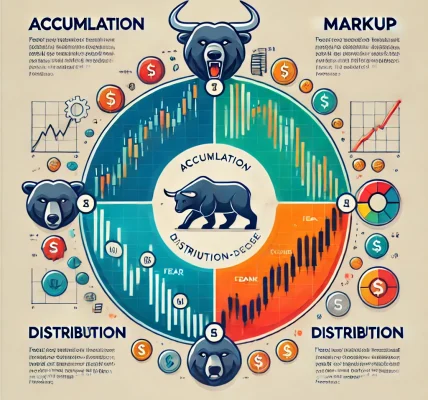Investing in the stock market requires careful analysis and informed decision-making. Whether you are a beginner or an experienced investor, using the right stock market indicators can help you identify trends, determine entry and exit points, and maximize profits while minimizing risks. In this guide, we will explore the most essential stock market indicators that every investor should know.
1. What Are Stock Market Indicators?
Stock market indicators are technical and fundamental metrics used by traders and investors to analyze price movements, market trends, and overall market health. These indicators provide valuable insights into whether a stock is overbought, oversold, trending upward, or at risk of decline.
There are two main types of stock market indicators:
- Leading Indicators: Predict future price movements.
- Lagging Indicators: Confirm trends after they have already started.
By understanding and using these indicators effectively, investors can make more informed trading decisions.
2. Essential Technical Indicators for Stock Market Analysis
Technical indicators help traders analyze stock price movements, trends, and market momentum. Here are the top technical indicators every investor should know:
A. Moving Averages (MA)
Moving averages smooth out price data over a specific period, helping traders identify trends.
- Simple Moving Average (SMA): The average price of a stock over a set number of days (e.g., 50-day or 200-day SMA).
- Exponential Moving Average (EMA): Gives more weight to recent prices, making it more responsive to price changes.
🔹 How to Use:
- If the price is above the 200-day SMA, the stock is in an uptrend.
- A golden cross (short-term MA crosses above long-term MA) signals a potential buy opportunity.
- A death cross (short-term MA crosses below long-term MA) signals a sell opportunity.
B. Relative Strength Index (RSI)
RSI measures the speed and change of price movements, ranging from 0 to 100.
- Above 70: Stock is overbought (potential sell signal).
- Below 30: Stock is oversold (potential buy signal).
🔹 How to Use:
- If RSI is above 70, the stock may experience a price pullback.
- If RSI is below 30, the stock could be undervalued and might rebound.
C. Moving Average Convergence Divergence (MACD)
MACD helps traders identify trend changes and momentum strength by comparing two moving averages.
- MACD Line (12-day EMA – 26-day EMA)
- Signal Line (9-day EMA of MACD Line)
🔹 How to Use:
- Bullish Signal: When MACD crosses above the Signal Line.
- Bearish Signal: When MACD crosses below the Signal Line.
D. Bollinger Bands
Bollinger Bands consist of:
- Middle Band: A simple moving average (SMA).
- Upper Band: SMA + standard deviation.
- Lower Band: SMA – standard deviation.
🔹 How to Use:
- When the price touches the upper band, the stock may be overbought.
- When the price touches the lower band, the stock may be oversold.
E. Volume Indicators (OBV & VWAP)
- On-Balance Volume (OBV): Measures buying and selling pressure based on volume changes.
- Volume Weighted Average Price (VWAP): Used by institutional traders to determine fair stock prices.
🔹 How to Use:
- Rising OBV indicates strong buying pressure.
- VWAP is used as a benchmark for fair pricing.
3. Fundamental Stock Market Indicators
Fundamental indicators help investors analyze a company’s financial health and valuation.
A. Price-to-Earnings Ratio (P/E Ratio)
- Formula: P/E = Stock Price ÷ Earnings Per Share (EPS)
- A high P/E ratio indicates a stock might be overvalued.
- A low P/E ratio suggests a stock might be undervalued.
🔹 How to Use: Compare a stock’s P/E ratio with industry peers to determine its relative valuation.
B. Earnings Per Share (EPS)
- Measures a company’s profitability.
- Formula: EPS = (Net Income – Dividends) ÷ Number of Shares Outstanding
🔹 How to Use: Higher EPS means a company is generating higher profits per share.
C. Dividend Yield
- Formula: Dividend Yield = Annual Dividend ÷ Stock Price
- A higher dividend yield indicates a stock pays more dividends relative to its price.
🔹 How to Use: Investors seeking passive income prefer stocks with high and stable dividend yields.
D. Debt-to-Equity Ratio (D/E Ratio)
- Formula: D/E = Total Debt ÷ Total Equity
- A lower D/E ratio indicates a company is financially stable with less debt.
🔹 How to Use: Avoid companies with extremely high debt, as they may struggle in economic downturns.
4. Market-Wide Indicators for Stock Market Trends
These indicators measure the overall market sentiment and trends.
A. The S&P 500 Index
Tracks the performance of 500 major U.S. companies, serving as a benchmark for market health.
B. The VIX (Volatility Index)
Known as the “Fear Index,” the VIX measures market volatility.
- High VIX: Market uncertainty and potential downturns.
- Low VIX: Stable market conditions.
C. Market Breadth Indicators
- Advance-Decline Ratio: Measures how many stocks are rising vs. declining.
- New Highs vs. New Lows: Tracks stocks hitting 52-week highs or lows.
5. How to Use These Indicators Together
No single indicator is perfect—using multiple indicators together increases accuracy.
Example Trading Strategy:
- Use Moving Averages to identify trends.
- Check RSI and Bollinger Bands for overbought/oversold levels.
- Confirm trend reversals with MACD.
- Verify market health using S&P 500 and VIX.
By combining indicators, investors can reduce risks and improve decision-making.
Conclusion
Stock market indicators are powerful tools that help investors make informed decisions. Whether you prefer technical indicators for price movements or fundamental indicators for company valuation, mastering these metrics can improve your trading success.
🔹 Key Takeaways:
- Moving Averages help identify trends.
- RSI & MACD show momentum shifts.
- P/E Ratio & EPS indicate a stock’s value.
- The VIX & S&P 500 measure market conditions.
By integrating these indicators into your strategy, you can become a more confident and successful investor. 📈🚀




